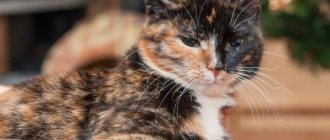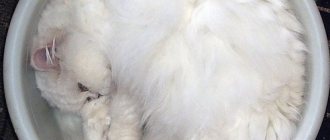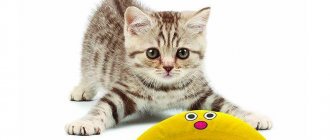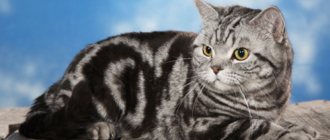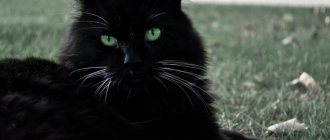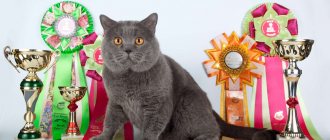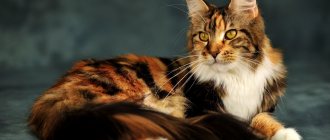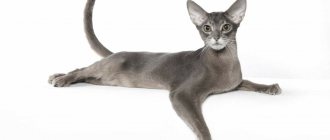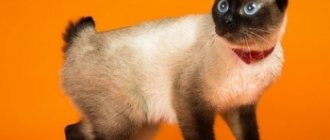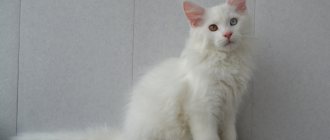The tricolor color of cats, which helps to camouflage in their natural environment and consists of a combination of black, white and red tones, was called calico, by analogy with the brightly colored calico fabric that was imported to England from the Indian city of Calicut.
Calico cat is not a breed; they include long-, short-, and hairless beauties with appropriate pigmentation. For the majority, international standards have been established, and they are allowed to participate in exhibitions and competitions on an equal basis with representatives of the same color of their breeds.
Genetics, description and features of tricolor color
The calico color predominates in girls, because... The X chromosome carries the gene that determines coat color. Females have two of them (XX), which allows the body to produce pigments:
- eumelanin, responsible for the black color;
- pheomelanin, which produces red.
White color is the predominant background on which spots of two other tones are located. Bright and saturated, with clearly defined edges are called “full”. Lightened, having bluish or creamy shades, with an undefined edge line - “diluted”.
Calico is often considered a variety of tortoiseshell color, but there is a difference between them: in the first case, white is the dominant color, and in the second, it is either completely absent or its presence is negligible.
For cats, this color is uncharacteristic due to the fact that their chromosome set implies the presence of only one such chromosome (XY) and is an exception to the rule. This trait is not selectively fixed. It appears spontaneously, cannot be controlled, and it is not possible to breed tricolor offspring to order.
Despite the fact that Calico cats belong to a variety of breeds, many galeophiles note similarities in their characters, behavior and manifestations of intelligence. It is believed that they are smart, clean, unhurried, and among their negative qualities there is cunning and willfulness.
Table “Complete Calico colors”
| Calico color | Wool colors | Specifics | Eye color |
| Black | Red and white with black | The orange pigment on an individual can have different shades | Dark yellow, dark copper |
| Chocolate | Chocolate-rich with white and red | Pigmentation is bright and uniform | Green, copper, orange |
| Cinnamon | Cinnamon color with white and orange | Color is not recognized as a breed color by international standards. | Green, amber |
The uneven orange color is due to the production of pheomelanin in the cat’s body, a pigment responsible for the yellow-red color. It is easily subject to change, because... depends not only on genetic predisposition, but also on nutrition and habitat.
Table “Diluted Calico Colors”
| Color name | Wool colors | Specifics | Eye color |
| Diluted Calico | White, cream, blue | The most sought after and rare pigmentation | Copper, green |
| Lilac Calico | White, lilac, cream | The color looks best on thick and long-haired breeds | Green, copper, orange |
| Cream fawn | White, cream, reindeer color | Color is not recognized as a breed color by international standards. | Green, dark yellow |
Only cats or cats can be tri-colored
The vast majority of triflowers are females. They make up over 95% of the total.
Male calicos are always an anomaly and evidence that the animal has Klinefelter syndrome (a rare disease that affects the number of chromosomes). Such cats have an unusual chromosome set (XXY), are characterized by poor health and a short life cycle. Aneuploidy (another name for the syndrome) negatively affects reproductive function and provokes infertility.
Tortoiseshell color and its variants
In order to present everything further in a transparent form, you need to understand: the tortoiseshell cat is not a breed at all, but just a variant of a unique color, a kind of smile of nature.
Tortoiseshell color
The tortoiseshell color system includes the colors black, red, silver, ash, and sand. Imagine these actions: they gathered all the colors into a single heap, got angry, began to grab and scatter them in the rhythm of chaos. All that comes out is tortoiseshell color.
Nature has given animals two types of coloring:
- Scaly turtles (Torti). The peculiarity of this “model” is that black and red colors are superimposed on each other. There are no clear boundaries between them. This type may represent a special uniqueness. Usually in this coloring one color is the leading one, but for two colors to be separated 50/50 is extremely rare. Siberian, Persian, and yard cats are a little more fortunate. For these representatives of the mustachios, the situation is somehow simpler: the scaly turtle color is more common.
- Patchwork (Calico) is an interesting type of color. The unique combination of black and red looks like a patchwork quilt. This color is typical for the Scots and British.
Tortie and calico
To systematize the color of cats, they were divided into two types:
- Torti - scaly color, spots on the coat resemble scales. It is simply impossible to find two representatives of this type of this type: the red and black spots are located in such a chaotic movement that it is simply impossible to carry out any selection actions.
- Calico, with its variegation, resembles a patchwork quilt. The patchwork color has different colored areas. Plush short hair is excellent: no cat connoisseur can simply be indifferent. The appearance of the spots can delight anyone with the clear boundaries of the spots that are clearly visible on the animal.
Tortoiseshell with white
The tortoiseshell and white color is distinguished by experts as a separate type. It is easy to understand that this color has white spots added to it, which give it a unique flavor.
British cat with color: tortoiseshell and white
The color can be either solid or patterned. The patterned tri-color has another pattern. A solid color does not have such a pattern. Additionally, it should be noted that each of the colors has its own individual shade, which turns the overall pattern into something incredible and cosmic. Only for this reason can one judge the variability of colors, which generally cannot be systematized.
Calico cat breeds
Of the 40 cat breeds, calico is found in only 15, and only 10 have established international standards for felinological organizations for admission to competitions. This:
- Maine Coon;
- Manx;
- American and British Shorthair;
- Persian;
- Neva Masquerade;
- Japanese and Kurilian bobtails;
- exotic;
- Turkish van.
In addition to them, the tricolor color can be observed in the Norwegian Forest cat, Siberian cat, as well as in the Selkirk, Devon and Cornish Rex.
Tortoiseshell color in various breeds
The genetic combination that gives the coat a tortoiseshell color can occur in any cat. Another thing is that it is not considered acceptable for every breed. Among the most popular domestic breeds, tortoiseshell colors may include the following:
- British;
- Scots;
- Siberian cats;
- Norwegian forest;
- Turkish Angora;
- Cornish Rex;
- bobtails of all varieties;
- sphinxes;
- orientals;
- Maine Coons;
- Persians.
All “turtles” are good, regardless of breed
The most common bizarre tortoiseshell color is found in ordinary outbred murks - there are simply much more of them than purebred animals. The genetics of the formation of this color are common to all cats, regardless of their purebred or outbred. But in each specific case it still looks different.
British and Scots
Both the British and Scottish cat breeds have gained well-deserved popularity around the world; fashion and demand for them have not gone away for a long time, not only in Foggy Albion, but also far beyond its borders. The tortoiseshell color is recognized by breed standards, and kittens with such coats are born very often. But breeders, alas, are not always happy about this.
Tortoiseshell is not the most popular color among British cats
The fact is that British tortoiseshell cats are not liked by experts and are rarely successful at shows. Consequently, they receive few titles and are valued lower than their peers with fur coats of other colors. The Scots often repeat the same story.
But Scottish cats of bright calico color are very attractive to buyers - and even the number of titles does not matter much. They really are just adorable!
Calico color suits Scottish cats very well
Siberian and Norwegian cats
Tricolor Siberian cats are rarely bright in color - the red and black spots in the tortoiseshell variation of this breed are usually blurred and weakened in pigment. But the patterns of Siberian “turtles” more often than other breeds contain a tabby pattern. And this is an undoubted advantage!
This baby will grow up to be a real Siberian beauty
The origin of Norwegian Forest cats is similar to Siberian cats - both breeds have aboriginal roots. But the tricolor of many Norwegians looks much richer than that of Siberians, which looks especially impressive on their rich fur coat.
Norwegian Forest in the tricolor version looks impressive
Turkish Angora
There is a misconception that Angora cats are exclusively white and have different eyes. Yes, this color is considered preferable in the Angora’s homeland, Turkey, but the world breed standard approves of various colors of these cats, including tortoiseshell and calico. This is good because tri-colored Angora cats are beautiful!
Such a cat will bring not only good luck to the house, but also beauty and good mood.
Cornish Rex
The curly, “tortoiseshell” Cornish Rex will not leave anyone indifferent. The unique coat structure of this breed makes any color exclusive, but tortoiseshell still remains unrivaled. With the unique grace and aristocratic build of these cats, he looks very bohemian and impressive. The breed standard does not allow too many colors, but tricolor variations are strongly encouraged.
The tortoiseshell coloration of the Cornish Rex involves the presence of red spots on the main black background of the coat.
Bobtails
Cat breeds with short tails (the result of a genetically fixed mutation) are cultivated in various countries. Bobtail standards welcome tricolor colors, and tortoiseshell in particular. Bobtails are interesting not only for their unusual appearance - they are smart and sociable, excellent in training and generally have a lot of advantages.
The Japanese Bobtail looks like a cheerfully colored hare with short ears.
Sphinxes
The tortoiseshell color on the bare skin of sphinxes looks unusual and even absolutely incredible. The demand for hairless breeds is constantly growing - fans of hairless cats are often attracted not even by the exotic appearance of their pets, but by their amazing affection and touching affection for humans, which not all breeds of domestic cats can boast of.
Isn't this Don Sphynx cat charming?
Orientals
The tortoiseshell color is one of the most popular in the rich palette of the Oriental breed - the standard allows for about four dozen color variations for these original animals. Smart and beautiful oriental cats are extraordinary in everything, from appearance to character . Therefore, the bizarre tortoiseshell patterns simply fit perfectly into the image of the breed - there is no more unusual color in nature.
Oh, who has such big ears and such a bad mood?
Maine Coons
The mysterious giant of the cat family is the Maine Coon, one of the largest domestic cats. The origin of the Maine Coon, its unusual history of the breed, its unique nature and impressive appearance - all this attracts attention and attracts the love of many fans. The tortoiseshell color looks very advantageous on the fur coats of representatives of this breed, adding wild impressiveness and mystery to the huge shaggy cats.
Maine Coon looks majestic as always
Persians, extreme sports and exotics
The Persian breed, in terms of its numbers and prevalence, undoubtedly breaks world records among domestic cats. And the breed branches of extreme sports and exotics that arose on its basis only add to the diversity and further expand the circle of lovers of these incomparable animals.
Although the peak of fashion and demand for Persians has already passed, this breed still has many loyal fans. They claim that the tortoiseshell pattern of the long coat perfectly complements the complex oriental image of the Persian cat, emphasizing its royal beauty and bright character.
Mongrel cats
The tortoiseshell cat can be found everywhere: both in a rural farmstead and on the streets of a big city. Despite the fact that many people are happy to take tricolor kittens into their homes, many of them remain strays. Don't pass by this colorful bundle of fluffy happiness - perhaps with his appearance in your life it will change for the better.
Beauty does not require documents
It doesn’t matter whether the cat has documents - outbred “tricolors” can boast not only beauty, but also intelligence, good health and strong genetics. It is in litters of yard “turtles” that most cats are born that inherit their mother’s color.
If you're lucky, there may be several "turtle" kittens in one litter.
Features of character and behavior
Of course, much in a cat’s character depends not on its color, but on its breed, genetics, living conditions and other factors. But in the behavior of most tortoiseshell cats, many similarities can be observed, which allows us to say: color also matters!
Tri-colored cats are unusually flexible and friendly - you can always come to an amicable agreement with them. At the same time, they are proud, independent, know what they want, and will not do what they do not like. They are persistent, and sometimes even too stubborn, and always try to get their way. However, the “turtles” are not doing this out of harm; they have a heightened sense of justice, which they try to restore wherever they are present.
A regal appearance requires aristocratic manners
The only authority for such a cat is its beloved owner. Only to him can she allow a lot and forgive him. But it is better for a stranger not to show familiarity and disrespect for such a royal person - he will instantly receive a harsh rebuff. Veterinarians say that tortoiseshell cats behave worse during appointments than all the others: well, they don’t like that the doctor takes liberties...
Of the obvious shortcomings of tricolors, only one can be named - they are poorly accustomed to the tray. If your pet has chosen a certain corner of the house to relieve itself, no force can force her to change the place for the toilet - it will be easier and more effective to move the litter tray to where she likes it. This is indeed a problem that many turtle owners complain about. Well, don’t forget to change the filling more often - a dirty tray is not suitable for royalty!
Tortoiseshell cats are caring mothers
Those who are lucky enough to own a calico cat admire its excellent maternal qualities - it turns out that color can also influence this.
Famous Calico cats
The popularity of tricolor beauties is reflected in the use of their image. Since October 2001, the calico has become the official symbol of the state of Maryland (USA). The Maneki-neko figurines common in Japan, which bring good luck, always depict a tri-colored cat.
And the Japanese mike (three-flowered) Tama saved the Kishi railway station, which was on the verge of ruin, from closure, received the title of samurai and became in 2007 “an honorary eternal station keeper.” The interest of tourists in the cat, which always greets passengers, turned out to be so great that this made it possible to solve the problem of financing.
And although Tama died in 2020, her place was immediately taken by another cat of the same color, which along with her position received the nickname Nitama (translated from Japanese as “second Tama”).
Signs about tricolor cats
Different peoples of the world have developed different signs associated with the image of the Calico cat, but what they have in common is that they are all positive. In America and Russia they were associated with money, profit, and material well-being. It is no coincidence that Russians call them “rich people,” and Americans call them money cats. Meeting one on the street means profit, and having one in the house means a stable financial situation.
Japanese beliefs testified that calico cats are indispensable for sea voyages and not a single ship will be wrecked if there is a mike on board. During the Edo era, selling them to sailors was a thriving business, bringing good profits to enterprising businessmen.
Even in skeptical Europe, meeting a cat of this color promised good luck and prosperity in business.
A miracle of genetics
Imagine her amazement when the veterinarian said that it was not a cat, but a cat! The doctor himself was surprised, because the birth of a three-colored calico cat is an extremely rare phenomenon, from a genetic point of view! Who would have thought that such an unusual cat would appear in Holly’s house and become her pet!
Photo source: www.thebuzztube.com
How did you get such a purr? The doctor explained that a cat with this color is a “product” of a rare gene mutation, so in nature, tri-colored “boys” are found in 1 in 3,000. Such cats are usually infertile, which means they cannot pass on their wonderful color to their offspring.
However, this was not the most important thing for Holly. The girl was very happy that the baby had recovered and his life was not in danger.
She decided for herself that she would never part with her pet for anything and would be the best friend for her pet, who has an affectionate and playful character!
Photo source: www.thebuzztube.com
Well, we are very glad that the little one survived thanks to Holly, and even turned out to be an unusual cat!
By the way, do you already know about the dog that was taught to walk again?
Liked? Be sure to follow us on , , Zen and
Source Photo source
